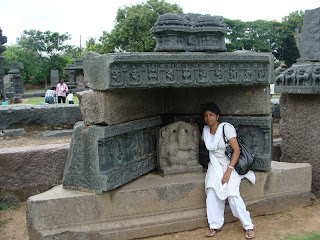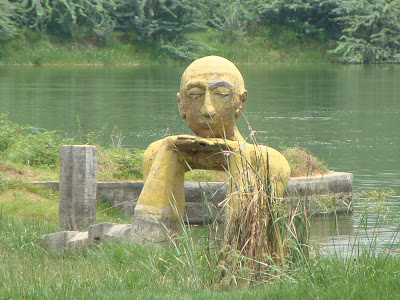On a guided tour we were driven past Charminar, lieu of parking restrictions near the monument. We had to postpone our visit to the next day. Luckily the visit to the edifice opens up at 9 am, we had to stand in the queue to buy the entry ticket of Rs 5 each. Once we were inside the premise, we had to undergo the security check at the gate, and bags are not allowed while climbing up. Luckily my wife was wearing a black churidar with the black hand bag, the security allowed us to go through. We had to climb 50 steps before we reached the first floor, which is equavalent to three floors in normal building. Beyond this we are not allowed for preserving the safety of the monument i presume. The next floor is supposed to have provision for Namaz for the Muslims.
History of Charminar : When an epidemic plague struck the capital of the Sultanate, the king Mohammad Qutub shah prayed to Allah, Please bless the city with peace and prosperity, let millions of men of all caste and creeds, and religions make this their abode, like fish in water. The foundation for Charminar was laid in 1591 and completed by 1595.
The edifice is built with four minaretes jutting out in four corners. A fable is floated that an underground tunnel exists to escape from Charminar to Golconda, but nobody is aware about its whereabouts. Each minar 56 metre high with winding staircase to reach the top. The minars are completed with a dome signifying Islamic architecture. There are two balconies leading up to the top, which is restricted to public visit.
When lit up in the night the edifice glows as if it has a golden sheen. Halogen lighting fixed at various points produces such an effect. The central hall is beautifully embedded with floral designs. There are inscriptions in Urdu praising the lord i presume. A mosque is built on the ground floor level, with the central portion barricaded with a fountain like structure.
The archways of the edifice is built in synchronisation leading up to third gateway, in one direction. The fluted shaped minars has totally 149 steps. When one ascends the top balcony, he gets to see bustling city of Hyderabad and Secunderabad, with Hussain Sagar lake, Zoo and Birla mandir, which are all prominent landmarks of the city.
On the left hand side there is Asaf Jung hospital with a domed structure and on the right we have the famous Mecca Masjid. These two structures are visible from the Charminar balcony. The Chowmahal Palace of the Nizams is a km away, but covered by buildings and shopping complexes.
The local administration has cleared up lot of space inorder to beautify the surroundings. At least if they are able to clear one side of the road filled with shops, the monument would look glorious. But the resistance to shift to alternative locations or take compensation is hindering the progress. Recently one of the minarets after 420 years was repaired through expert guidance of ASI engineers. Check out the chaotic traffic in front of Charminar.
The Iconic Charminar is compared to Taj Mahal in terms of being a symbol representing the city. It would augur well if a committee is formed to spruce up the place to bring back the past glory. The solution lies in clearing at least one km of space on one side and relocating the shops.
Ack : Photo from Hyderbad tourist site, courtsey wiki.
History of Charminar : When an epidemic plague struck the capital of the Sultanate, the king Mohammad Qutub shah prayed to Allah, Please bless the city with peace and prosperity, let millions of men of all caste and creeds, and religions make this their abode, like fish in water. The foundation for Charminar was laid in 1591 and completed by 1595.
The edifice is built with four minaretes jutting out in four corners. A fable is floated that an underground tunnel exists to escape from Charminar to Golconda, but nobody is aware about its whereabouts. Each minar 56 metre high with winding staircase to reach the top. The minars are completed with a dome signifying Islamic architecture. There are two balconies leading up to the top, which is restricted to public visit.
When lit up in the night the edifice glows as if it has a golden sheen. Halogen lighting fixed at various points produces such an effect. The central hall is beautifully embedded with floral designs. There are inscriptions in Urdu praising the lord i presume. A mosque is built on the ground floor level, with the central portion barricaded with a fountain like structure.
The archways of the edifice is built in synchronisation leading up to third gateway, in one direction. The fluted shaped minars has totally 149 steps. When one ascends the top balcony, he gets to see bustling city of Hyderabad and Secunderabad, with Hussain Sagar lake, Zoo and Birla mandir, which are all prominent landmarks of the city.
On the left hand side there is Asaf Jung hospital with a domed structure and on the right we have the famous Mecca Masjid. These two structures are visible from the Charminar balcony. The Chowmahal Palace of the Nizams is a km away, but covered by buildings and shopping complexes.
The local administration has cleared up lot of space inorder to beautify the surroundings. At least if they are able to clear one side of the road filled with shops, the monument would look glorious. But the resistance to shift to alternative locations or take compensation is hindering the progress. Recently one of the minarets after 420 years was repaired through expert guidance of ASI engineers. Check out the chaotic traffic in front of Charminar.
The Iconic Charminar is compared to Taj Mahal in terms of being a symbol representing the city. It would augur well if a committee is formed to spruce up the place to bring back the past glory. The solution lies in clearing at least one km of space on one side and relocating the shops.
Ack : Photo from Hyderbad tourist site, courtsey wiki.




































